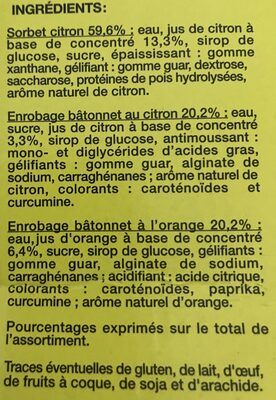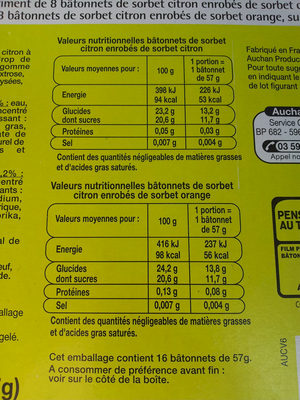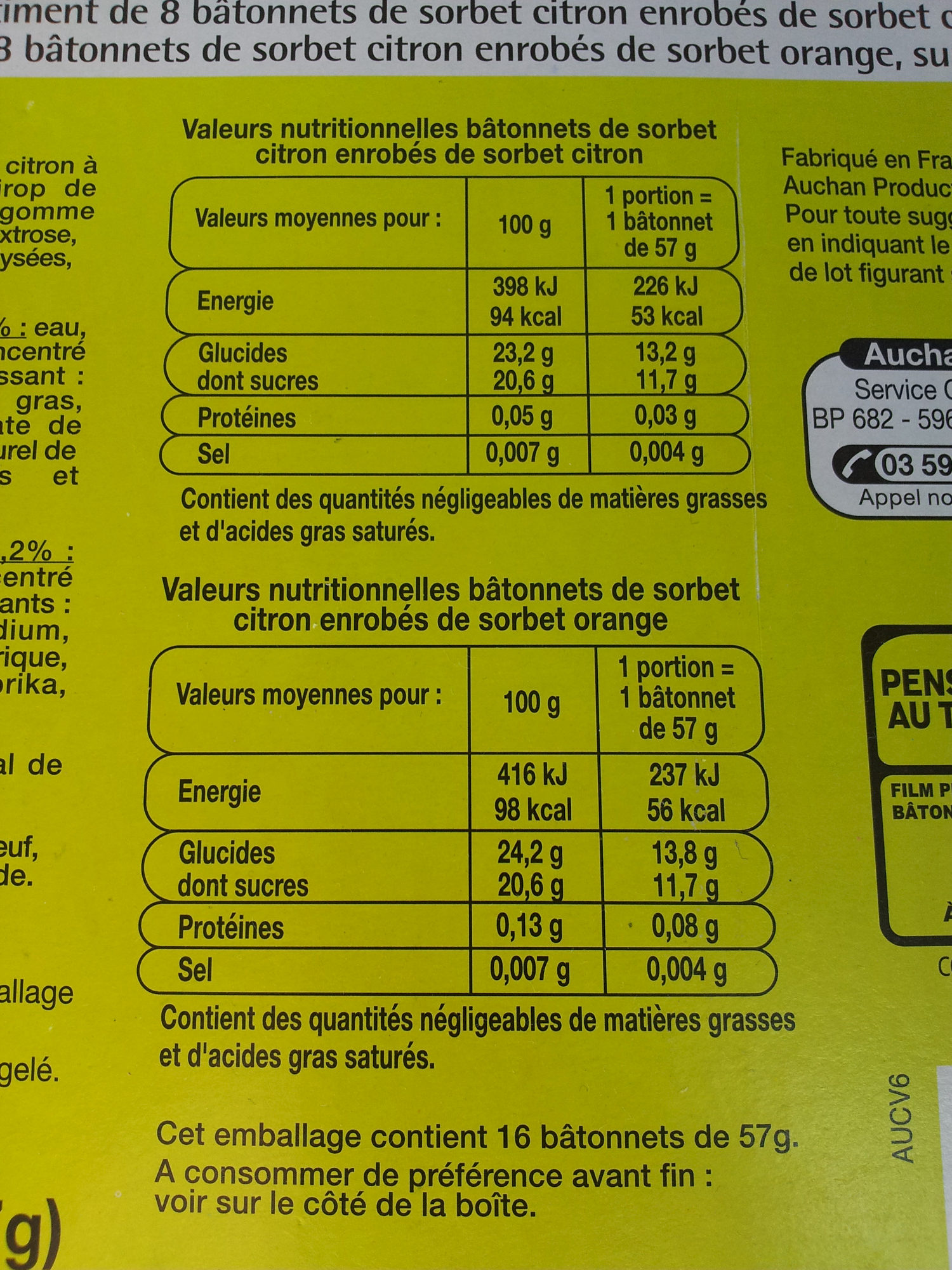Help us make food transparency the norm!
As a non-profit organization, we depend on your donations to continue informing consumers around the world about what they eat.
The food revolution starts with you!
16 bâtonnets citron/orange - Pouce - 912 g
16 bâtonnets citron/orange - Pouce - 912 g
Important note: this product is no longer sold. The data is kept for reference only. This product does not appear in regular searches and is not taken into account for statistics. (Withdrawal date: 2023/07/01)
This product page is not complete. You can help to complete it by editing it and adding more data from the photos we have, or by taking more photos using the app for Android or iPhone/iPad. Thank you!
×
Some of the data for this product has been provided directly by the manufacturer AUCHAN APAW.
Barcode: 3596710440498 (EAN / EAN-13)
Quantity: 912 g
Categories: Desserts, Frozen foods, Frozen desserts, Ice pops
Stores: Auchan
Countries where sold: France
Matching with your preferences
Health
Ingredients
-
43 ingredients
: Sorbet citron 59,6% : eau, jus de citron à base de concentré 13,3%, sirop de glucose, sucre, épaississant : gomme xanthane, gélifiant : gomme guar, dextrose, saccharose, protéines de pois hydrolisées, arôme naturel de citron; Enrobage bâtonnet au citron 20,2% : eau, sucre, jus de citron à base de concentré 3,3%, sirop de glucose, antimoussant mono - et diglycérides d’acides gras, gélifiants : gomme guar, alginate de sodium, carraghénanes ; arôme naturel de citron, colorants : caroténoïdes et curcumine. Enrobage bâtonnet à l’orange 20,2% ; eau, jus d'orange à base de concentré 6,4%, sucre, sirop de glucose, gélifiants : gomme guar, alginate de sodium, carraghénanes ; acidifiant : acide citrique, · colorants : caroténoïdes, paprika, val curcumine ; arôme naturel d’orange.Traces: Eggs, Gluten, Milk, Nuts, Peanuts, Soybeans
Food processing
-
Ultra processed foods
Elements that indicate the product is in the 4 - Ultra processed food and drink products group:
- Additive: E100 - Curcumin
- Additive: E160 - Carotenoids
- Additive: E401 - Sodium alginate
- Additive: E407 - Carrageenan
- Additive: E412 - Guar gum
- Additive: E415 - Xanthan gum
- Ingredient: Colour
- Ingredient: Dextrose
- Ingredient: Flavouring
- Ingredient: Gelling agent
- Ingredient: Glucose
- Ingredient: Glucose syrup
- Ingredient: Thickener
Food products are classified into 4 groups according to their degree of processing:
- Unprocessed or minimally processed foods
- Processed culinary ingredients
- Processed foods
- Ultra processed foods
The determination of the group is based on the category of the product and on the ingredients it contains.
Additives
-
E330 - Citric acid
Citric acid is a natural organic acid found in citrus fruits such as lemons, oranges, and limes.
It is widely used in the food industry as a flavor enhancer, acidulant, and preservative due to its tart and refreshing taste.
Citric acid is safe for consumption when used in moderation and is considered a generally recognized as safe (GRAS) food additive by regulatory agencies worldwide.
-
E407 - Carrageenan
Carrageenan (E407), derived from red seaweed, is widely employed in the food industry as a gelling, thickening, and stabilizing agent, notably in dairy and meat products.
It can exist in various forms, each imparting distinct textural properties to food.
However, its degraded form, often referred to as poligeenan, has raised health concerns due to its potential inflammatory effects and its classification as a possible human carcinogen (Group 2B) by the International Agency for Research on Cancer (IARC).
Nevertheless, food-grade carrageenan has been deemed safe by various regulatory bodies when consumed in amounts typically found in food.
-
E412 - Guar gum
Guar gum (E412) is a natural food additive derived from guar beans.
This white, odorless powder is valued for its remarkable thickening and stabilizing properties, making it a common ingredient in various food products, including sauces, dressings, and ice creams.
When used in moderation, guar gum is considered safe for consumption, with no known adverse health effects.
-
E415 - Xanthan gum
Xanthan gum (E415) is a natural polysaccharide derived from fermented sugars, often used in the food industry as a thickening and stabilizing agent.
This versatile food additive enhances texture and prevents ingredient separation in a wide range of products, including salad dressings, sauces, and gluten-free baked goods.
It is considered safe for consumption even at high intake amounts.
Ingredients analysis
-
Palm oil free
No ingredients containing palm oil detected
Unrecognized ingredients: fr:sorbet-citron, fr:proteines-de-pois-hydrolisees, fr:enrobage-batonnet-au-citron, fr:antimoussant-mono-et-diglycerides-d-acides-gras, fr:enrobage-batonnet-a-l-orange, fr:val-curcumineSome ingredients could not be recognized.
We need your help!
You can help us recognize more ingredients and better analyze the list of ingredients for this product and others:
- Edit this product page to correct spelling mistakes in the ingredients list, and/or to remove ingredients in other languages and sentences that are not related to the ingredients.
- Add new entries, synonyms or translations to our multilingual lists of ingredients, ingredient processing methods, and labels.
If you would like to help, join the #ingredients channel on our Slack discussion space and/or learn about ingredients analysis on our wiki. Thank you!
-
Vegan status unknown
Unrecognized ingredients: fr:sorbet-citron, fr:proteines-de-pois-hydrolisees, fr:enrobage-batonnet-au-citron, fr:antimoussant-mono-et-diglycerides-d-acides-gras, fr:enrobage-batonnet-a-l-orange, fr:val-curcumineSome ingredients could not be recognized.
We need your help!
You can help us recognize more ingredients and better analyze the list of ingredients for this product and others:
- Edit this product page to correct spelling mistakes in the ingredients list, and/or to remove ingredients in other languages and sentences that are not related to the ingredients.
- Add new entries, synonyms or translations to our multilingual lists of ingredients, ingredient processing methods, and labels.
If you would like to help, join the #ingredients channel on our Slack discussion space and/or learn about ingredients analysis on our wiki. Thank you!
-
Vegetarian status unknown
Unrecognized ingredients: fr:sorbet-citron, fr:proteines-de-pois-hydrolisees, fr:enrobage-batonnet-au-citron, fr:antimoussant-mono-et-diglycerides-d-acides-gras, fr:enrobage-batonnet-a-l-orange, fr:val-curcumineSome ingredients could not be recognized.
We need your help!
You can help us recognize more ingredients and better analyze the list of ingredients for this product and others:
- Edit this product page to correct spelling mistakes in the ingredients list, and/or to remove ingredients in other languages and sentences that are not related to the ingredients.
- Add new entries, synonyms or translations to our multilingual lists of ingredients, ingredient processing methods, and labels.
If you would like to help, join the #ingredients channel on our Slack discussion space and/or learn about ingredients analysis on our wiki. Thank you!
-
Details of the analysis of the ingredients
We need your help!
Some ingredients could not be recognized.
We need your help!
You can help us recognize more ingredients and better analyze the list of ingredients for this product and others:
- Edit this product page to correct spelling mistakes in the ingredients list, and/or to remove ingredients in other languages and sentences that are not related to the ingredients.
- Add new entries, synonyms or translations to our multilingual lists of ingredients, ingredient processing methods, and labels.
If you would like to help, join the #ingredients channel on our Slack discussion space and/or learn about ingredients analysis on our wiki. Thank you!
: Sorbet citron 59.6% (eau), jus de citron à base de concentré 13.3%, sirop de glucose, sucre, épaississant (gomme xanthane), gélifiant (gomme guar), dextrose, saccharose, protéines de pois hydrolisées, arôme naturel de citron, Enrobage bâtonnet au citron 20.2% (eau), sucre, jus de citron à base de concentré 3.3%, sirop de glucose, antimoussant mono- et diglycérides d'acides gras, gélifiants (gomme guar), alginate de sodium, carraghénanes, arôme naturel de citron, colorants (caroténoïdes, curcumine, Enrobage bâtonnet à l'orange 20.2%), eau, jus d'orange à base de concentré 6.4%, sucre, sirop de glucose, gélifiants (gomme guar), alginate de sodium, carraghénanes, acidifiant (acide citrique), colorants (caroténoïdes), paprika, val curcumine, arôme naturel d'orange- Sorbet citron -> fr:sorbet-citron - percent: 59.6
- eau -> en:water - vegan: yes - vegetarian: yes - ciqual_food_code: 18066
- jus de citron à base de concentré -> en:lemon-juice-from-concentrate - vegan: yes - vegetarian: yes - ciqual_food_code: 2028 - percent: 13.3
- sirop de glucose -> en:glucose-syrup - vegan: yes - vegetarian: yes
- sucre -> en:sugar - vegan: yes - vegetarian: yes
- épaississant -> en:thickener
- gomme xanthane -> en:e415 - vegan: yes - vegetarian: yes
- gélifiant -> en:gelling-agent
- gomme guar -> en:e412 - vegan: yes - vegetarian: yes
- dextrose -> en:dextrose - vegan: yes - vegetarian: yes
- saccharose -> en:sucrose - vegan: yes - vegetarian: yes
- protéines de pois hydrolisées -> fr:proteines-de-pois-hydrolisees
- arôme naturel de citron -> en:natural-lemon-flavouring - vegan: yes - vegetarian: yes
- Enrobage bâtonnet au citron -> fr:enrobage-batonnet-au-citron - percent: 20.2
- eau -> en:water - vegan: yes - vegetarian: yes - ciqual_food_code: 18066
- sucre -> en:sugar - vegan: yes - vegetarian: yes
- jus de citron à base de concentré -> en:lemon-juice-from-concentrate - vegan: yes - vegetarian: yes - ciqual_food_code: 2028 - percent: 3.3
- sirop de glucose -> en:glucose-syrup - vegan: yes - vegetarian: yes
- antimoussant mono- et diglycérides d'acides gras -> fr:antimoussant-mono-et-diglycerides-d-acides-gras
- gélifiants -> en:gelling-agent
- gomme guar -> en:e412 - vegan: yes - vegetarian: yes
- alginate de sodium -> en:e401 - vegan: yes - vegetarian: yes
- carraghénanes -> en:e407 - vegan: yes - vegetarian: yes
- arôme naturel de citron -> en:natural-lemon-flavouring - vegan: yes - vegetarian: yes
- colorants -> en:colour
- caroténoïdes -> en:e160 - vegan: maybe - vegetarian: maybe
- curcumine -> en:e100 - vegan: yes - vegetarian: yes
- Enrobage bâtonnet à l'orange -> fr:enrobage-batonnet-a-l-orange - percent: 20.2
- eau -> en:water - vegan: yes - vegetarian: yes - ciqual_food_code: 18066
- jus d'orange à base de concentré -> en:orange-juice-from-concentrate - vegan: yes - vegetarian: yes - percent: 6.4
- sucre -> en:sugar - vegan: yes - vegetarian: yes
- sirop de glucose -> en:glucose-syrup - vegan: yes - vegetarian: yes
- gélifiants -> en:gelling-agent
- gomme guar -> en:e412 - vegan: yes - vegetarian: yes
- alginate de sodium -> en:e401 - vegan: yes - vegetarian: yes
- carraghénanes -> en:e407 - vegan: yes - vegetarian: yes
- acidifiant -> en:acid
- acide citrique -> en:e330 - vegan: yes - vegetarian: yes
- colorants -> en:colour
- caroténoïdes -> en:e160 - vegan: maybe - vegetarian: maybe
- paprika -> en:paprika - vegan: yes - vegetarian: yes - ciqual_food_code: 11049
- val curcumine -> fr:val-curcumine
- arôme naturel d'orange -> en:natural-orange-flavouring - vegan: maybe - vegetarian: maybe
Nutrition
-
Poor nutritional quality
⚠ ️Warning: the amount of fiber is not specified, their possible positive contribution to the grade could not be taken into account.⚠ ️Warning: the amount of fruits, vegetables and nuts is not specified on the label, it was estimated from the list of ingredients: 23This product is not considered a beverage for the calculation of the Nutri-Score.
Positive points: 0
- Proteins: 0 / 5 (value: 0, rounded value: 0)
- Fiber: 0 / 5 (value: 0, rounded value: 0)
- Fruits, vegetables, nuts, and colza/walnut/olive oils: 0 / 5 (value: 23, rounded value: 23)
Negative points: 14
- Energy: 1 / 10 (value: 393, rounded value: 393)
- Sugars: 4 / 10 (value: 20.6, rounded value: 20.6)
- Saturated fat: 9 / 10 (value: 10, rounded value: 10)
- Sodium: 0 / 10 (value: 2.8, rounded value: 2.8)
The points for proteins are not counted because the negative points are greater or equal to 11.
Nutritional score: 14 (14 - 0)
Nutri-Score: D
-
Nutrient levels
-
Fat in moderate quantity (10%)
What you need to know- A high consumption of fat, especially saturated fats, can raise cholesterol, which increases the risk of heart diseases.
Recommendation: Limit the consumption of fat and saturated fat- Choose products with lower fat and saturated fat content.
-
Saturated fat in high quantity (10%)
What you need to know- A high consumption of fat, especially saturated fats, can raise cholesterol, which increases the risk of heart diseases.
Recommendation: Limit the consumption of fat and saturated fat- Choose products with lower fat and saturated fat content.
-
Sugars in high quantity (20.6%)
What you need to know- A high consumption of sugar can cause weight gain and tooth decay. It also augments the risk of type 2 diabetes and cardio-vascular diseases.
Recommendation: Limit the consumption of sugar and sugary drinks- Sugary drinks (such as sodas, fruit beverages, and fruit juices and nectars) should be limited as much as possible (no more than 1 glass a day).
- Choose products with lower sugar content and reduce the consumption of products with added sugars.
-
Salt in low quantity (0.007%)
What you need to know- A high consumption of salt (or sodium) can cause raised blood pressure, which can increase the risk of heart disease and stroke.
- Many people who have high blood pressure do not know it, as there are often no symptoms.
- Most people consume too much salt (on average 9 to 12 grams per day), around twice the recommended maximum level of intake.
Recommendation: Limit the consumption of salt and salted food- Reduce the quantity of salt used when cooking, and don't salt again at the table.
- Limit the consumption of salty snacks and choose products with lower salt content.
-
-
Nutrition facts
Nutrition facts As sold
for 100 g / 100 mlCompared to: Ice pops Energy 393 kj
(94 kcal)+10% Fat 10 g +2,069% Saturated fat 10 g +3,590% Carbohydrates 24.2 g +22% Sugars 20.6 g +18% Fiber ? Proteins 0 g -100% Salt 0.007 g -68% Fruits‚ vegetables‚ nuts and rapeseed‚ walnut and olive oils (estimate from ingredients list analysis) 23 %
Environment
-
Eco-Score A - Very low environmental impact
⚠ ️Select a country in order to include the full impact of transportation.The Eco-Score is an experimental score that summarizes the environmental impacts of food products.→ The Eco-Score was initially developped for France and it is being extended to other European countries. The Eco-Score formula is subject to change as it is regularly improved to make it more precise and better suited to each country.Life cycle analysis
-
Average impact of products of the same category: A (Score: 93/100)
Category: Ice lolly
Category: Ice lolly
- PEF environmental score: 0.17 (the lower the score, the lower the impact)
- including impact on climate change: 0.90 kg CO2 eq/kg of product
Stage Impact Agriculture
43.2 %Processing
22.0 %Packaging
9.0 %Transportation
10.6 %Distribution
9.7 %Consumption
5.6 %
Bonuses and maluses
-
Missing origins of ingredients information
Malus: -5
⚠ ️ The origins of the ingredients of this product are not indicated.
If they are indicated on the packaging, you can modify the product sheet and add them.
If you are the manufacturer of this product, you can send us the information with our free platform for producers.
-
Packaging with a low impact
Malus: -1
Shape Material Recycling Impact Unknown Cardboard Low ⚠ ️ The information about the packaging of this product is not sufficiently precise (exact shapes and materials of all components of the packaging).⚠ ️ For a more precise calculation of the Eco-Score, you can modify the product page and add them.
If you are the manufacturer of this product, you can send us the information with our free platform for producers.
Eco-Score for this product
-
Impact for this product: A (Score: 87/100)
Product: 16 bâtonnets citron/orange - Pouce - 912 g
Life cycle analysis score: 93
Sum of bonuses and maluses: -6
Final score: 87/100
-
Carbon footprint
-
Equal to driving 0.5 km in a petrol car
90 g CO² per 100g of product
The carbon emission figure comes from ADEME's Agribalyse database, for the category: Ice lolly (Source: ADEME Agribalyse Database)
Stage Impact Agriculture
20.6 %Processing
25.0 %Packaging
20.0 %Transportation
24.4 %Distribution
7.2 %Consumption
2.8 %
Packaging
-
Packaging with a low impact
-
Packaging parts
(Cardboard)
-
Packaging materials
Material % Packaging weight Packaging weight per 100 g of product Paper or cardboard
-
Transportation
-
Origins of ingredients
Missing origins of ingredients information
⚠ ️ The origins of the ingredients of this product are not indicated.
If they are indicated on the packaging, you can modify the product sheet and add them.
If you are the manufacturer of this product, you can send us the information with our free platform for producers.Add the origins of ingredients for this product Add the origins of ingredients for this product
Report a problem
-
Incomplete or incorrect information?
Category, labels, ingredients, allergens, nutritional information, photos etc.
If the information does not match the information on the packaging, please complete or correct it. Open Food Facts is a collaborative database, and every contribution is useful for all.
Data sources
Product added on by openfoodfacts-contributors
Last edit of product page on by org-auchan-apaw.
Product page also edited by autorotate-bot, jlbo, kiliweb, packbot, sebleouf, tacite, teolemon, yuka.WXBwWkRKZ2hqZFlWZ3ZBNzNUWGExZFVybVoyS1dtR0tkTVUvSUE9PQ.











